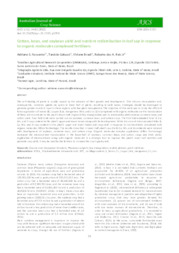Publicações
Cotton, bean, and soybean yield and nutrient redistribution in leaf sap in response to organic molecules complexed fertilizers.
Autoria: NASCENTE, A. S.; COBUCCI, T.; BRASIL, V.; REIS JUNIOR, R. dos A.
Resumo: The self-shading of plants is usually caused by the advance of their growth and development. This reduces transpiration and, consequently, nutrients uptake via xylem in lower half of plants, resulting in yield losses. Strategies should be developed to promote greater nutrient input in these regions with low-plant transpiration. The objective of this work was to study the effect of foliar application of boron (B), copper (Cu), manganese (Mn), and zinc (Zn) complexed with organic molecules on the translocation of these micronutrients to the plant’s lower half (region of low transpiration) and its relationship with soybean, common bean, and cotton yield. Two field trials were carried out on soybean, common bean, and cotton crops. The first trial evaluated foliar B, Cu, Mn, and Zn sap content in the plant's upper and lower halves along with its development. While the second trial evaluated foliar B, Cu, Mn, and Zn sap content in the plant's upper and lower-halves and crop yield in response to micronutrients complexed with organic molecules (Xiflon Technology). The results show that in lower-half plant’s sap the B, Cu, Mn, and Zn contents were reduced with development of soybean, common bean, and cotton crops. Organic molecular complex application (Xiflon Technology) increased the micronutrient translocation in the lower-half of soybean, common bean, and cotton crops and their yields. Application of micronutrients along with organic molecules is a strategic tool to improve the plant's lower-half nutrition and promote crop yield. It may be used by the farmers to increase the crop’s grain yield
Ano de publicação: 2023
Tipo de publicação: Artigo de periódico
Unidade: Embrapa Arroz e Feijão
Palavras-chave: Algodão, Beans, Cotton, Evapotranspiration, Evapotranspiração, Feijão, Glycine Max, Gossypium Hirsutum, Low transpiration, Mobile phloem, Nutrição Vegetal, Phaseolus Vulgaris, Phloem, Plant nutrition, Pólen, Soja, Soybeans

